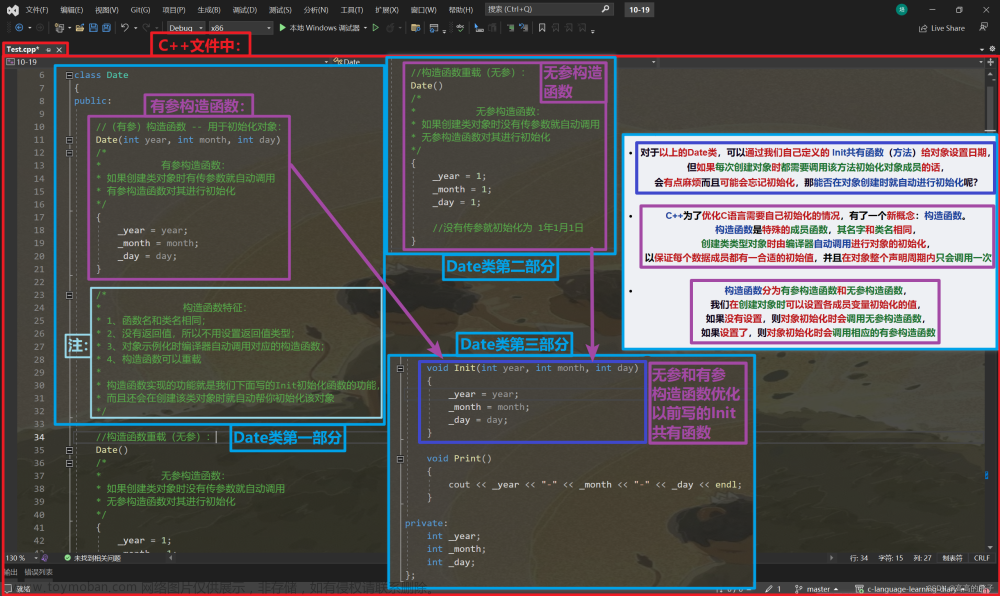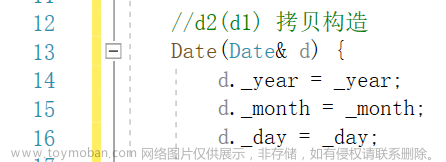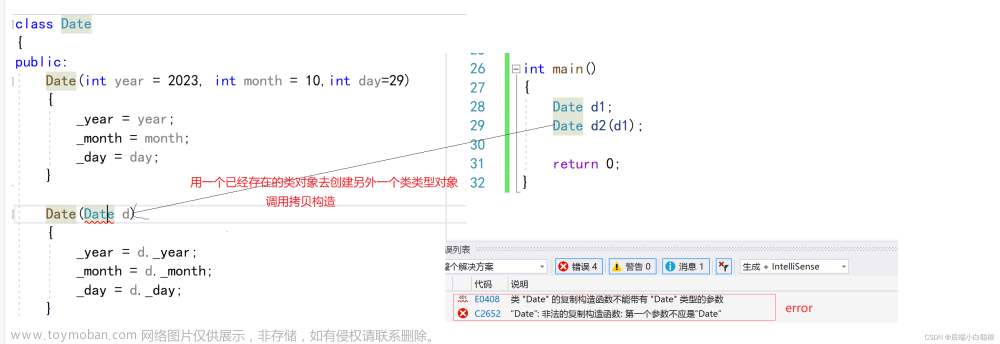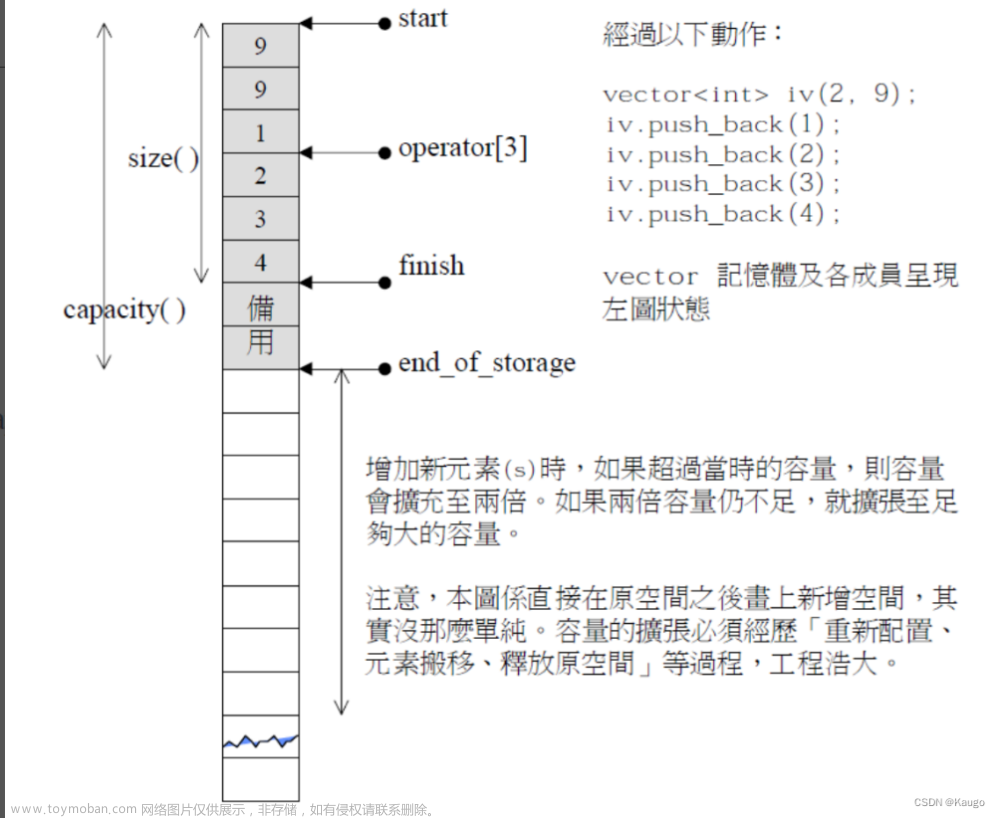深拷贝与浅拷贝
浅拷贝:简单的赋值拷贝操作
深拷贝:在堆区重新申请空间,进行拷贝
利用编译器提供的拷贝构造函数,会做浅拷贝操作;会导致堆区的内存重复释放
![[Pasted image 20221216213144.png]]
解决方法:
利用深拷贝进行解决。
#include<iostream>
using namespace std;
class Person
{
public:
Person()
{
cout << "Person的默认构造函数调用!" << endl;
}
Person(int a, int height)
{
m_Age = a;
m_Height = new int(height); // 通过new将数据创建在堆区, new的返回值为 指针 即深拷贝
// 堆区的数据需要程序员手动释放
cout << "Person的有参构造函数调用!" << endl;
}
// 自己实现一个拷贝构造函数, 解决浅拷贝带来的问题
Person(const Person &p)
{
cout << "Person 拷贝构造函数的调用!" << endl;
m_Age = p.m_Age;
//m_Height = p.m_Height; // 编译器进行浅拷贝的操作
// 深拷贝
m_Height = new int(*p.m_Height);
}
~Person()
{
// 析构代码, 将堆区开辟的数据释放
if (m_Height != NULL)
{
delete m_Height;
m_Height = NULL; // 置空防止野指针。
}
cout << "Person的析构函数调用!" << endl;
}
int m_Age;
int *m_Height;
};
void test01()
{
Person p1(18, 160);
Person p2(p1); // 相对于浅拷贝
cout << "p1的年龄:" << p1.m_Age << "p1的身高:" << *p1.m_Height << endl;
cout << "p2的年龄:" << p2.m_Age << "p2的身高:" << *p2.m_Height << endl;
}
int main()
{
test01();
return 0;
}
初始化列表
语法:构造函数():属性1(值1),属性2(值2),...{}
#include<iostream>
using namespace std;
// 初始化列表
class Person2
{
public:
Person2(int a, int b, int c): m_A(a), m_B(b),m_C(c) {};
int m_A;
int m_B;
int m_C;
};
void test02()
{
Person2 p(10, 20, 30);
cout << "p.m_A = " << p.m_A << endl;
cout << "p.m_B = " << p.m_B << endl;
cout << "p.m_C = " << p.m_C << endl;
}
int main()
{
test02();
return 0;
}
![[Pasted image 20221216215208.png]]
类对象作为类成员
- 当其他类对象作为本类成员,构造时先构造其他类对象,在构造自身
- 析构函数与之相反
![[Pasted image 20221217212136.png]]
#include<iostream>
#include<string>
using namespace std;
class Phone
{
public:
Phone(string pName) : m_PName(pName)
{
cout << "Phone 构造函数调用!" << endl;
}
~Phone()
{
cout << "Phone 析构函数调用!" << endl;
}
string m_PName;
};
// 类对象作为类成员
class Person
{
public:
Person(string name, string pName) : m_Name(name), m_Phone(pName)
{
cout << "Person 构造函数调用!" << endl;
}
~Person()
{
cout << "Person 析构函数调用!" << endl;
}
// 姓名
string m_Name;
// 手机
Phone m_Phone;
};
void test01()
{
Person p("张三", "iphpne 13 pro");
cout << p.m_Name << "有 " << p.m_Phone.m_PName << "手机" << endl;
}
int main()
{
test01();
return 0;
}
静态成员函数
特点:
- 静态成员(函数、变量)所有类对象共享同一个静态成员函数或者静态成员变量
- 静态成员函数只能访问静态成员变量
- 因为静态成员函数无法区分非静态成员变量到底属于哪个对象,而静态成员变量是所有对象共享的因此不存在上述问题
2.
- 因为静态成员函数无法区分非静态成员变量到底属于哪个对象,而静态成员变量是所有对象共享的因此不存在上述问题
- 静态成员函数有访问权限
- 类外访问不到私有静态成员函数

- 类外访问不到私有静态成员函数
#include<iostream>
using namespace std;
// 静态成员函数,所有对象共享同一个函数
// 静态成员函数,只能访问静态成员变量
class Person
{
public:
// 静态成员函数
static void func()
{
m_A = 100; // 静态成员函数可以访问静态成员变量,因为静态成员所有对象共享该成员,不存在区分是哪个对象的问题。
//m_B = 100; // 静态成员函数不可以访问非静态成员变量,无法区分到底是哪个对象的m_B属性。
cout << "static void func() 函数调用 " << endl;
}
static int m_A; // 静态成员变量 必须在类内声明。在类外初始化
int m_B; // 非静态成员变量
private:
static void func2()
{
cout << "static void func2() 函数调用 " << endl;
}
};
int Person::m_A = 0; // 静态成员变量初始化
void test01()
{
//1.通过对象访问静态成员函数
Person p;
p.func();
//2. 通过类名访问
Person::func();
//Person::func2(); // 类外不能访问私有的静态成员函数
}
int main()
{
test01();
return 0;
}
this 指针
成员变量和成员函数分开存储
C++中,类内的成员变量和成员函数分开存储
- 非静态成员变量 属于类的对象上的数据
- 静态成员变量 不属于某个对象上的数据,因此不占用对象内存
- 非静态成员函数 不属于类对象上的数据,因此不占用对象内存
- 静态成员函数 不属于类对象上的数据,因此不占用对象内存
只有非静态成员变量才属于属于类的对象上的数据
#include<iostream>
using namespace std;
// 成员变量和成员函数分开存储
class Person
{
int m_A; // 非静态成员变量 属于类的对象上的数据
static int m_B; // 静态成员变量 不属于某个对象上的数据,因此不占用对象内存
void func() {}; // 非静态成员函数 不属于类对象上的数据,因此不占用对象内存
static void fucn2() {}; // 静态成员函数 不属于类对象上的数据,因此不占用对象内存
};
void test01()
{
Person p;
// 空对象占用内存为1个字节
// C++编译器会给每个空对象分配一个字节空间,是为了区分空对象占内存的位置
// 每个空对象也应该有一个独一无二的内存地址
cout << "空对象占用内存:" << sizeof(p) << endl;
}
void test02()
{
Person p;
cout << "对象占用内存:" << sizeof(p) << endl;
}
int main()
{
//test01();
test02();
return 0;
}
this指针
C++中成员变量和成员函数是分开存储的,每个非静态成员函数只会诞生一份函数实例,即多个同类型的对象会公用同一块代码,如何区分是哪个对象调用该dai?
通过this指针指向被调用的成员函数所属的对象
this指针是隐含每一个非静态成员函数内的一种指针
this指针不需要定义,直接使用即可
1.解决名称冲突
如图,在没用this时,编译器认为三个age是同一个,类的属性不相干。
解决方法:
(1).成员变量和参数名成编码不同,在成员变量前加m进行区分
(2).使用this指针
2.返回对象本身用 *this
#include<iostream>
using namespace std;
// this指针
class Person
{
public:
Person(int age)
{
// this指针指向被调用的成员函数所属的对象
this->age = age;
}
Person& PersonAddAge(Person &p)
{
this->age += p.age;
// this是指向p2的指针,而*this指向的就是p2
return *this; // 返回类型为引用
// 为什么返回引用呢?因为如果返回不是引用则编译器会重新创建一个对象,而不是返回该对象本身
}
int age;
};
// 1.解决名称冲突
void test01()
{
Person p1(10);
cout << "p1的年龄:" << p1.age << endl;
}
// 2.返回对象本身用 *this
void test02()
{
Person p1(10);
Person p2(18);
// 链式编程思想
p2.PersonAddAge(p1).PersonAddAge(p1).PersonAddAge(p1);
cout << "p2的年龄:" << p2.age << endl;
}
int main()
{
//test01();
test02();
return 0;
}
空指针访问成员函数
C++中空指针可以调用成员函数,要注意有没有用到this指针
如果用到this指针,要判断保证代码的健壮性
用空指针调用成员函数,访问对象的某个属性时报错,原因:
是因为传入的指针是NULL,要判断是否为空,保证代码的健壮性。
![[Pasted image 20221219194610.png]]
#include<iostream>
using namespace std;
// 空指针调用成员函数
class Person
{
public:
void showClassName()
{
cout << "This is Person." << endl;
}
void showPersonAge()
{
// 传入的指针为NULL,因此发生报错
// 要想用this指针可以使用
if (this == NULL)
{
return; // 防止报错,提高健壮性
}
cout << "age = " << this->m_Age << endl;
}
int m_Age;
};
void test01()
{
Person *p = NULL; // 空指针
p->showClassName();
p->showPersonAge();
}
int main()
{
test01();
return 0;
}
const修饰成员函数中
常函数
1.成员函数后加const 为常函数
2.常函数内不可以修改成员属性
![[Pasted image 20221219203922.png]]
3.成员属性声明时加关键字mutable后,则在常函数中可以修改
this指针的本质是指针常量,指针的指向无法修改
this指针相对于 Person *const this; 指针的指向无法修改, 但是其指向的值可以修改 即 this->某个属性 = ?
若想限制this指向的值,需设为 const Person *const this;
常对象
1.声明对象前加const称该对象为常对象
2.常对象只能调用常函数
常对象 不能修改普通变量
![[Pasted image 20221219204035.png]]
常对象不能调用普通成员函数,因为普通成员函数可以修改成员属性
友元
如果类的私有属性想让类外的特殊函数或者类进行访问时,需要用到友元
友元的目的是让一个函数或者类访问另一个类中的私有成员
友元的三种实现:
1.全局函数做友元
#include<iostream>
#include<string>
using namespace std;
// 1. 全局函数做友元
class Building
{
// 全局函数goodGay是Building 的友元类,可以访问Building的私有成员
friend void goodGay(Building &building);
public:
Building()
{
m_SittingRoom = "客厅";
m_BedRoom = "卧室";
}
public:
string m_SittingRoom; //客厅
private:
string m_BedRoom; //卧室
};
// 全局函数
void goodGay(Building &building)
{
cout << "好基友的全局函数,正在访问:" << building.m_SittingRoom << endl;
cout << "好基友的全局函数,正在访问:" << building.m_BedRoom << endl;
}
void test01()
{
Building build;
goodGay(build);
}
int main()
{
test01();
return 0;
}
2.类做友元
#include<iostream>
#include<string>
using namespace std;
// 2.类做友元
class Building; // 类声明
class GoodGay
{
public:
GoodGay();
void visit(); // 参观函数,访问building中的属性
Building * building;
};
class Building
{
friend class GoodGay;
public:
Building();
public:
string m_SittingRoom; // 客厅
private:
string m_BedRoom; // 卧室
};
// 类外写成员函数
Building::Building()
{
m_SittingRoom = "客厅";
m_BedRoom = "卧室";
}
GoodGay::GoodGay()
{
// 创建一个building类的对象
building = new Building;
}
void GoodGay::visit()
{
cout << "GoodGay类正在访问:" << building->m_SittingRoom << endl;
cout << "GoodGay类正在访问:" << building->m_BedRoom << endl;
}
void test01()
{
GoodGay gg;
gg.visit();
}
int main()
{
test01();
return 0;
}
友元类是单向的,即类B是类A的友元类,但类A不是类B的友元类
友元类不能传递,即类B是类A的友元类,类C是类B的友元类,但类C不是类A的友元类
3.成员函数做友元
#include<iostream>
#include<string>
using namespace std;
// 3.成员函数做友元
class Building;
class GoodGay
{
public:
GoodGay();
void vist(); // 让该函数可以访问Building中的私有成员
void vist2(); // 让该函数不可以访问Building中的私有成员
Building * building;
};
class Building
{
friend void GoodGay::vist(); // 将GoodGay中的vist()函数声明为友元,使其可以访问Building类的私有成员
public:
Building();
public:
string m_SittingRoom; // 客厅
private:
string m_BedRoom; // 卧室
};
Building::Building()
{
m_SittingRoom = "客厅";
m_BedRoom = "卧室";
}
GoodGay::GoodGay()
{
building = new Building;
}
void GoodGay::vist()
{
cout << "GoodGay类vist()函数正在访问:" << building->m_SittingRoom << endl;
cout << "GoodGay类vist()函数正在访问:" << building->m_BedRoom << endl;
}
void GoodGay::vist2()
{
cout << "GoodGay类vist()函数正在访问:" << building->m_SittingRoom << endl;
//cout << "GoodGay类vist()函数正在访问:" << building->m_BedRoom << endl;
}
void test01()
{
GoodGay gg;
gg.vist();
gg.vist2();
}
int main()
{
test01();
return 0;
}
运算符重载
概念:对已有的运算符重新进行定义,赋予其另一种功能,以适应不同的数据类型
加号运算符重载
作用:实现两个自定义数据类型的相加运算
1.成员函数重载运算符 其本质是自定义数据类型 对象 = 对象1 + operator(对象2)
2.全局函数重载运算符 其本质是``自定义数据类型 对象 = operator(对象1 + 对象2)`
3.运算符重载也可以发生函数重载
注意事项
1.对于内置的数据类型的表达式的运算符不可能改变
2.不能随意滥用运算符重载(改变运算符规则比如将+号改为-的功能)
#include<iostream>
using namespace std;
// 运算符重载
// 1.加号运算符重载
class Person
{
public:
Person() {};
// 1.1 通过成员函数重载加号
//Person operator + (Person &p)
//{
// Person temp;
// temp.m_A = this->m_A + p.m_A;
// temp.m_B = this->m_B + p.m_B;
// return temp;
//}
public:
int m_A;
int m_B;
};
// 1.2 通过全局函数重载加号
Person operator + (Person &p1, Person &p2)
{
Person temp;
temp.m_A = p1.m_A + p2.m_A;
temp.m_B = p1.m_B + p2.m_B;
return temp;
}
// 函数重载的版本
Person operator +(Person &p1, int m)
{
Person temp;
temp.m_A = p1.m_A + m;
temp.m_B = p1.m_B + m;
return temp;
}
void test01()
{
Person p1;
p1.m_A = 10;
p1.m_B = 6;
Person p2;
p2.m_A = 5;
p2.m_B = 6;
// 成员函数重载和全局函数重载调用
/*Person p3;
p3 = p1 + p2;*/
// 成员函数重载的本质调用
//Person p3 = p1.operator+(p2);
// 全局成员函数重载的本质调用
Person p3 = operator+(p1, p2);
cout << "p3.m_A = " << p3.m_A << endl;
cout << "p3.m_B = " << p3.m_B << endl;
// 运算符重载也可以发生函数重载
Person p4 = p1 + 20;
cout << "p4.m_A = " << p4.m_A << endl;
cout << "p4.m_B = " << p4.m_B << endl;
}
int main()
{
test01();
return 0;
}
左移运算符重载
重载左移运算符配合友元可以实现输出自定义数据类型
本质:void operator << (ostream &cout, Person &p) // 本质 operator<<(cout, p) 只有这样才能简化为 cout << p
#include<iostream>
using namespace std;
// 运算符重载
// 1.加号运算符重载
// 2.左移运算符(输出)重载
class Person
{
public:
Person() {};
friend ostream& operator << (ostream &cout, Person &p);
Person(int a, int b)
{
m_A = a;
m_B = b;
}
// 2.1 通过成员函数重载 << 运算符
// 通常不会利用成员函数重载 << 运算符,因为无法实现cout 在左侧
void operator << (ostream &cout)
{
cout << "m_A = " << this->m_A << ",m_B = " << this->m_B << endl;
}
private:
int m_A;
int m_B;
};
// 2.2 通过全局函数重载左移运算符(输出运算符)
// cout 为 输出流 ostream类,cin 为输入流 istream类;且程序有且只能有一个cout和cin,因此将输入输出流cin、cout作为参数时要以引用的方式
//void operator << (ostream &cout, Person &p) // 本质 operator<<(cout, p) 只有这样才能简化为 cout << p
//{
// cout << "m_A = " << p.m_A << ",m_B = " << p.m_B << endl;
//}
ostream& operator << (ostream &cout, Person &p) // 本质 operator<<(cout, p) 只有这样才能简化为 cout << p
{
cout << "m_A = " << p.m_A << ",m_B = " << p.m_B << endl;
return cout;
}
void test02()
{
Person p(10, 20);
p << cout; // 成员函数重载 << 只能实现cout在右侧
cout << p;
cout << p << endl;// 全局函数重载 << 可以实现cout在左侧 如果重载函数返回的是void则不可以进行链式输出;只有当重载函数返回为输出\输入流类时才能使用链式输出
}
int main()
{
//test01();
test02();
return 0;
}
注意事项:
1.通常不会利用成员函数重载 << 运算符,因为无法实现cout 在左侧
2.cout 为 输出流 ostream类,cin 为输入流 istream类;且程序有且只能有一个cout和cin,因此将输入输出流cin、cout作为参数时要以引用的方式
3.全局函数重载 << 可以实现cout在左侧 如果重载函数返回的是void则不可以进行链式输出;只有当重载函数返回为输出\输入流类时才能使用链式输出
递增运算符重载
1.前置递增重载 返回类型为 引用
返回引用是为了可以链式++ 时是在自身对象中进行的数据类型名& operator++()
2.后置递增重载,返回类型为 类型值
以为后置递增返回的是++之前的值,而不是++后的自身的值
3.后置递增重载,要写int 占位符,来使编译器区分前置和后置数据类型名 operator++(int)
#include<iostream>
using namespace std;
// 3.重载递增运算符
// 自定义整型
class MyInteger
{
friend ostream& operator <<(ostream& out, MyInteger myint);
public:
MyInteger()
{
m_Num = 0;
}
// 重载 前置++ 运算符
MyInteger& operator ++() // 返回引用是为了可以链式++ 时是在自身对象中进行的
{
// 先进行++运算
m_Num++;
// 再将自身做返回
return *this;
}
// 重载 后置++ 运算符
// int 代表占位参数,可以用于区分前置和后置递增 只能用int
// 返回类型为 值 而不是引用
MyInteger operator++(int)
{
// 先 记录当时的结果
MyInteger temp = *this;
// 在 自身进行++运算
m_Num++;
// 最后 返回记录的当时的结果
return temp;
}
// 重载 前置-- 运算符
MyInteger & operator--()
{
m_Num--;
return *this;
}
// 重载后置--运算符
MyInteger operator--(int)
{
MyInteger temp = *this;
m_Num--;
return temp;
}
private:
int m_Num;
};
void test03()
{
MyInteger myint;
cout << myint << endl;
cout << ++myint << endl;
cout << myint << endl;
}
void test04()
{
MyInteger myint;
cout << myint << endl;
cout << myint++ << endl;
cout << myint << endl;
}
void test05()
{
MyInteger myint;
cout << "重载前置--" << endl;
cout << myint << endl;
cout << --myint << endl;
cout << myint << endl;
}
void test06()
{
MyInteger myint;
cout << "重载后置--" << endl;
cout << myint << endl;
cout << myint-- << endl;
cout << myint << endl;
}
int main()
{
test03();
test04();
test05();
test06();
return 0;
}

赋值运算符重载
默认operator = 是浅拷贝:在执行析构函数时,导致堆区的同一个内存重复释放,程序崩溃。
#include<iostream>
using namespace std;
// 4.赋值运算符重载
class Person2
{
public:
Person2(int age)
{
m_Age = new int(age);
}
~Person2()
{
if (*m_Age)
{
delete m_Age;
m_Age = NULL;
}
}
int *m_Age;
};
void test07()
{
Person2 p1(10);
Person2 p2(20);
p2 = p1; // 赋值操作 浅拷贝,在释放指针内存时会导致报错
cout << "p1的年龄:" << *p1.m_Age << endl;
cout << "p2的年龄:" << *p2.m_Age << endl;
}
int main()
{
test07();
return 0;
}

解决方法:深拷贝,在堆区中重新开辟一个空间,存放赋值操作符所赋值的值 文章来源:https://www.toymoban.com/news/detail-425563.html
文章来源:https://www.toymoban.com/news/detail-425563.html
#include<iostream>
using namespace std;
// 4.赋值运算符重载
class Person2
{
public:
Person2(int age)
{
m_Age = new int(age);
}
~Person2()
{
if (*m_Age)
{
delete m_Age;
m_Age = NULL;
}
}
// 重载运算符
Person2& operator = (Person2 &p) // 返回引用!!!进行链式引用
{
// 编译器提供的是浅拷贝 m_Age = p.m_Age;
// 应该先判断是否有数据存放在堆区,若有 应释放后在做深拷贝
if (m_Age != NULL)
{
delete m_Age;
m_Age = NULL;
}
m_Age = new int(*p.m_Age);
return *this;
}
int *m_Age;
};
void test07()
{
Person2 p1(10);
Person2 p2(20);
Person2 p3(30);
p2 = p1 = p3; // 赋值操作 浅拷贝,在释放指针内存时会导致报错
cout << "p1的年龄:" << *p1.m_Age << endl;
cout << "p2的年龄:" << *p2.m_Age << endl;
cout << "p3的年龄:" << *p3.m_Age << endl;
}
int main()
{
test07();
return 0;
}
关系运算符重载
#include<iostream>
using namespace std;
// 5. 重载关系运算符
class Person3
{
public:
Person3(string name, int age) : m_Name(name), m_Age(age){}
// 重载 == 操作符
bool operator == (Person3 &p)
{
if (this->m_Age == p.m_Age && this->m_Name == p.m_Name)
{
return true;
}
else {
return false;
}
}
// 重载 != 操作符
bool operator != (Person3& p)
{
if (this->m_Age == p.m_Age && this->m_Name == p.m_Name)
{
return false;
}
else {
return true;
}
}
// 重载 > 操作符
bool operator > (Person3& p)
{
if (this->m_Age > p.m_Age && this->m_Name != p.m_Name)
{
return true;
}
else {
return false;
}
}
string m_Name;
int m_Age;
}
// 5. 重载关系运算符
void test08()
{
Person3 p1("Tom", 20);
Person3 p2("Tom", 21);
Person3 p3("Tom", 20);
if (p1 > p2)
{
cout << "p1大于p2" << endl;
}
else {
cout << "p1小于p2" << endl;
}
if (p1 == p3)
{
cout << "p1与p3相等" << endl;
}
else {
cout << "p1与p3不相等" << endl;
}
}
int main()
{
test08();
return 0;
}
 文章来源地址https://www.toymoban.com/news/detail-425563.html
文章来源地址https://www.toymoban.com/news/detail-425563.html
函数调用运算符重载
到了这里,关于【C++学习笔记】对象的特性的文章就介绍完了。如果您还想了解更多内容,请在右上角搜索TOY模板网以前的文章或继续浏览下面的相关文章,希望大家以后多多支持TOY模板网!







![[开发语言][c++][python]:C++与Python中的赋值、浅拷贝与深拷贝](https://imgs.yssmx.com/Uploads/2024/02/785412-1.png)





